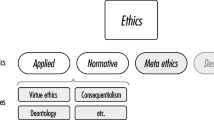Abstract
The age of technological society demands that ethical concerns of the path are not forgotten. Technological powering of a personal act shortens the gap between organization and person, and personal ethical concerns then face a dilemma. Indian’s thought suggests that if a mental state of equanimity without contention prevails over as a process, the evils and demerits disappear and ethical dissonance reduces because there is no common evil. Further, it is no longer necessary to translate potential consequences of the choices in terms of risks. Liberty peace and love in this technological time come through the state where the approach is for hands-off.
Similar content being viewed by others
Explore related subjects
Discover the latest articles, news and stories from top researchers in related subjects.References
Agamben G (1999) Potentialities: collected essays in philosophy. Tr. & Ed. By D. Heller-Roazen. Stanford University Press, CA
Baudrillard J (1998) The consumer society: myths and structures. Sage, Thousand Oaks
Dutta MN (1975) Ethics. The Mohendra Publishing Committee, Calcutta
Garceau O (1940) Organized medicine enforces its ‘party line’. Public Opinion Q 4(3):404–428
Heidegger M (1954/1993) ‘The question concerning technology’ in Basic Writings. Harper-Collins, New York, pp 311–341
Kafka F (1991) The Great Wall of China and other short works. Tr. & edited by M. Pasley. Penguin Books, London
Lassard D, Miller R (2001) Understanding and managing risks in large engineering projects. Sloan Working Paper 4214-01. MIT Sloan School of Management
Milgram S (1967) The small world problem. Psychol Today 1(1):61–67
Tetsuro W (1988) Climate and culture: a philosophical study. Greenwood Press, New York
Williamson OE (1993) The evolving science of organization. J Inst Theor Econ 149(1):36–63
Author information
Authors and Affiliations
Corresponding author
Rights and permissions
About this article
Cite this article
Banerjee, P. Ethical issues in our times of technology: select exploration. AI & Soc 28, 383–388 (2013). https://doi.org/10.1007/s00146-013-0514-7
Received:
Accepted:
Published:
Issue Date:
DOI: https://doi.org/10.1007/s00146-013-0514-7



